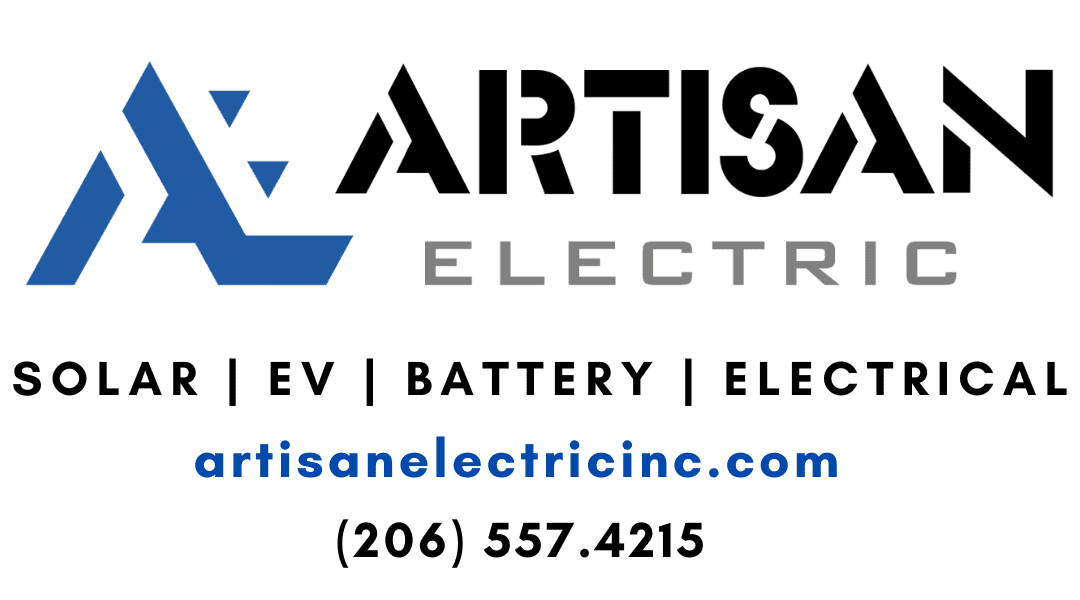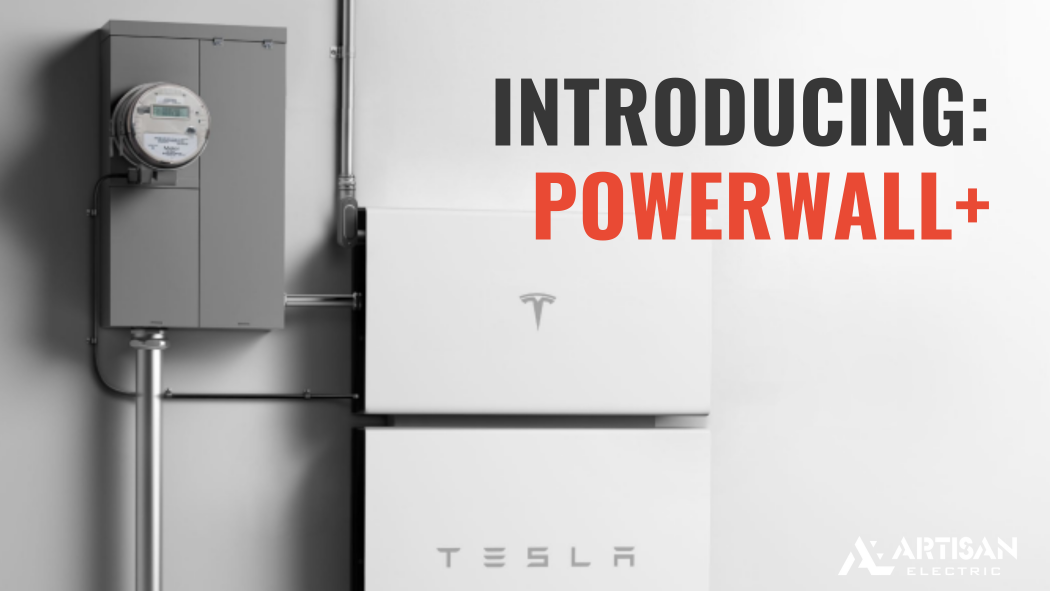What is a Tesla Powerwall+ ?
The Tesla Powerwall+ combines a 7.6kW Tesla string inverter with a 13.5kWh Tesla Powerwall 2 battery into a single unit. This integration offers several benefits including reduced equipment costs, a higher maximum discharge rate and maximum capacity from the battery, and a more efficient installation process.
Understanding Home Battery Storage
Home battery storage systems, like Tesla’s Powerwall, provide a way for homeowners to keep and use electricity generated by their solar panels when the sun isn’t shining. Here’s how it works: Solar panels capture sunlight and convert it into direct current (DC) electricity. This DC is then changed into alternating current (AC) by an inverter so it can power your home.
Any electricity that isn’t used right away gets stored in the battery. This stored power comes in handy at night or on overcast days when solar output dips. The Powerwall uses cutting-edge lithium-ion technology to store energy efficiently and delivers it back to your home when needed, offering a steady supply of clean, renewable energy.
A key point to remember is that solar panels by themselves don’t provide power during grid outages, mainly for safety—to avoid sending electricity back to the grid and risking the safety of workers addressing the outage. With a system like the Powerwall, however, your home can remain powered during an outage since the system can operate independently from the full grid power, and use the stored energy to keep your lights and appliances running.
How does Tesla Powerwall work?
The Tesla Powerwall not only stores energy but also pairs seamlessly with solar panels to enhance energy security and offer significant financial advantages. It comes fully equipped with sophisticated energy monitoring, metering, and customizable smart controls accessible through the Tesla app. This full battery energy storage system is designed to learn from your energy habits over time and continuously improves through over-the-air software updates, introducing new functionalities and refining existing ones.
With Solar:
Solar panels are great at capturing solar energy during daylight to power homes and businesses. But there might be times when they don’t produce enough energy to meet your demands, forcing you to draw expensive power from the grid. That’s where a hybrid setup becomes valuable. Hybrid solar systems can seamlessly switch between connecting to the grid and operating independently, providing flexibility and affordable uninterrupted power.
Without Solar:
Electricity costs can fluctuate throughout the day. The Powerwall is smart enough to charge itself when electricity rates are at their lowest and conserve its stored energy for when rates peak, maximizing your cost savings.
Additionally, the Powerwall is always on alert for power outages, automatically kicking in to supply your home with reliable backup power and effectively becoming the primary home backup energy source when the grid is down. This capability ensures your home remains powered under all circumstances.
Powerwall vs Powerwall Plus
Tesla’s Powerwall 2 and Powerwall Plus are standout choices for home battery storage, yet they differ in several important ways.
Powerwall 2 Overview:
- Capacity: Offers a usable energy storage capacity of 13.5 kWh.
- Efficiency: Operates with a 90% round-trip efficiency.
- Installation Flexibility: Can be mounted on both the floor and wall, and is suitable for indoor or outdoor installation.
- Integrated Inverter: Includes an integrated inverter to simplify setup, converting stored DC power into AC power for home use.
Powerwall Plus Overview:
- Increased Capacity: Features a slightly higher energy capacity of 14 kWh.
- Enhanced Power: Boasts a power capability of 9.6 kW, providing more robust support for larger homes.
- Solar Integration: Specifically designed to work with solar panel installations and requires a separate inverter.
- Advanced Energy Management: Includes an integrated backup gateway to manage energy use, monitor grid outages, and ensure efficient operation.
Key Differences:
- Inverter Integration: The most notable difference is the inverter technology. The Powerwall Plus comes equipped with a built-in solar inverter, also known as a grid-tied inverter. This allows the unit to directly convert DC power from rooftop solar panels into usable AC power for household appliances, enhancing efficiency and reducing installation complexity.
The choice between Powerwall 2 and Powerwall Plus largely depends on your home’s energy needs, the size, existing solar installations, and desired efficiency. For detailed specifications on the Powerwall Plus, you can refer to the Tesla spec sheet provided on their website.
The similarities of Powerwall 2 and Powerwall+
Both the Powerwall 2 and Powerwall Plus are engineered for daily use, which involves regular charging and discharging to optimize energy savings. Here are some key similarities:
- Daily Cycling: Designed to handle daily charge and discharge cycles to maximize your home’s energy efficiency.
- System Integration: Each unit must be installed as part of a grid-tied system, ensuring that they work in conjunction with the electrical grid.
- Scalability: Both models can be stacked or combined, allowing for increased storage capacity. This is particularly useful for homes needing full backup capabilities, as multiple units may be required.
- Reliability during Outages: A crucial feature of both units is their ability to provide power during grid outages, ensuring your home remains operational even when local power fails.
Powerwall 2 Capacity and Features
The Powerwall 2 is Tesla’s advanced home battery system, known for its substantial energy storage and reliable performance:
- Storage Capacity: Comes with a 13.5 kWh storage capacity.
- Power Output: Delivers 7 kW peak and 5 kW continuous power, suitable for most residential needs.
- Solar Compatibility: Works well with both new and existing solar installations, including those using microinverters.
- Warranty: Tesla backs the Powerwall 2 with a 10-year warranty, emphasizing its durability and long-term reliability.
Tesla Powerwall Plus specs
General Specifications:
- Nominal Battery Energy: 13.5 kWh
- Grid Voltage (Input / Output): 208 VAC and 120/240 VAC
- Grid Voltage Range: 183 – 228.8 VAC and 211.2 – 264 VAC
- Frequency: 60 Hz
- Phase: 240 VAC: 2W + N + GND
Performance on Grid:
- Maximum Continuous Power (On-Grid): 5 kW input / 6.6 kW output, extending to 7.6 kW output
- Maximum Continuous Current (On-Grid): 32 A output
Performance Off Grid:
- Maximum Continuous Power (Off-Grid): 5 kW input / 9.6 kW output
- Maximum Continuous Current (Off-Grid): 40 A output
Battery and Energy Storage System (BESS):
- Continuous Power: 5 kW input/output
- Continuous Current: 24 A input
Solar Compatibility:
- PV Maximum Input Voltage: 600 VDC
- PV Operating DC Input Voltage Range: 60 – 550 VDC
- PV DC MPPT Voltage Range: 60 – 480 VDC
- Maximum Power Point Trackers (MPPTs): 4
- Input Connectors per MPPT: Configurations 1-2-1-2
- Maximum Current per MPPT (Imp): 13 A, extendable up to 26 A using jumpers
- Maximum Short Circuit Current per MPPT (Isc): 19 A, extendable up to 38 A using jumpers
- Overcurrent Protection Device: 50 A
Efficiency and Interfaces:
- Round Trip Efficiency: 90% (AC to battery to AC, at beginning of life)
- Output Power Factor Rating: +/– 0.9 to 1
- Customer Interface: Tesla Mobile App
- Internet Connectivity: Wi-Fi, Ethernet, Cellular (LTE/4G) – subject to network coverage
- PV AC Metering: Revenue grade accuracy (+/-0.5%)
Safety and Protection:
- Protections: Integrated arc fault circuit interrupter (AFCI), Rapid Shutdown
Physical Characteristics:
- Dimensions: 1596 mm x 755 mm x 160 mm (62.8 in x 29.7 in x 6.3 in)
- Total Weight: 140 kg (310 lbs) – does not include bracket
- Battery Assembly Weight: 118 kg (261 lbs)
- Solar Assembly Weight: 22 kg (49 lbs)
- Mounting Options: Floor or wall mount
Environmental Tolerance:
- Operating Temperature: –20°C to 50°C (–4°F to 122°F)
- Operating Humidity: Up to 100%, condensing
- Storage Conditions: –20°C to 30°C (–4°F to 86°F), up to 95% RH, non-condensing
- Maximum Elevation: 3000 m (9843 ft)
- Enclosure Type: Type 3R
- Noise Level: < 40 dB(A) optimal, < 50 dB(A) maximum
Tesla Powerwall Plus Pricing
When considering home battery options, the bulk of the expense typically lies in the hardware. A typical installation of the PowerWall+ to a 10kW grid-tied solar PV system usually costs around $13,000. In contrast, adding a Powerwall 2 for battery backup to an existing system might cost upwards of $19,000, depending on the complexity of the installation.
These costs can vary based on specific on-site requirements. If you’re thinking about integrating solar with storage or upgrading your current solar setup, scheduling a consultation with a solar expert is recommended to get tailored advice and precise estimates.
Lifespan and Cost of Replacement for Tesla Powerwall Batteries
A Tesla Powerwall can generally last up to 20 years, with an expected functional lifespan of about 10 years under normal usage conditions. The typical replacement cost for a Tesla Powerwall battery is approximately $3,500, although this can vary depending on the model and your geographical location. Investing in a Tesla Powerwall can lead to substantial long-term savings on energy costs and also contribute to reducing your environmental impact.
Benefits of Powerwall Plus
The Powerwall Plus enhances the standard features of the Powerwall 2 by incorporating a built-in integrated solar inverter. This integration allows the Powerwall Plus to directly accept DC electricity from solar panels, eliminating the need for additional solar inverters.
The design simplifies the overall solar plus storage system and can provide more efficient energy conversion. Notably, as of 2024, the Powerwall 3 has been introduced, offering flexible functionalities akin to both the Powerwall 2 and Powerwall 3 Plus, with expandable storage capacity via battery extension packs instead of adding more complete units.
Advantages of Powerwall Plus in Low Sunlight Conditions
The Powerwall Plus is particularly advantageous for homes with limited sun exposure due to shading from trees, buildings, or other structures. The powerwall system’s integrated inverter and advanced energy management capabilities ensure optimal use of the sunlight that does reach your solar panels, enhancing overall efficiency.
The Powerwall Plus is designed to maximize battery capacity by charging during peak sunlight and to utilize stored energy effectively when sunlight is insufficient. Additionally, its compatibility with hybrid inverters allows for seamless switching between solar-generated power and battery reserves, making it ideal for shaded environments where sunlight availability can be inconsistent.
Is It Worth Getting a Powerwall?
Choosing a Tesla Powerwall is worthwhile if you are looking for a cost-effective and powerful battery storage solution. Especially for those setting up a new solar system, needing backup power, or requiring the capability to run large appliances during outages, the Powerwall presents an excellent option. With its competitive pricing and robust performance, the Powerwall, particularly compared to the latest models, offers significant utility and reliability. Contact us today to find out if PowerWall+ is right for you.
Contact us today to find out if PowerWall+ is right for you.

